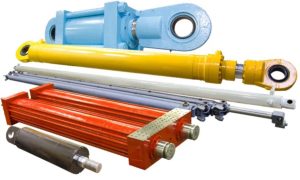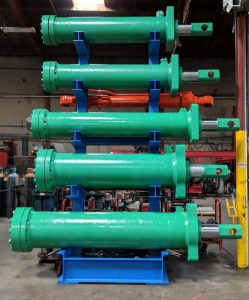Whether you want to better master cylinder technology or find cylinder solutions for your own machine, this one is suitable for you. In this post, we will be discussing the mechanisms and principles of excavator cylinder, as well as the benefits and challenges of using them. We will begin with an introduction about hydraulic cylinders for excavator, and then move onto the mechanisms and principles of excavator hydraulic cylinders. Following this, we will discuss the benefits of using excavator hydraulic cylinders, before concluding with the challenges of using them. Read on to understand what hydraulic cylinder is and how it works.
In the most basic case, hydraulic cylinders convert pressure into motion. Howver, in most cases, they are designed to do one of two things – push or pull. If you look around a heavy construction equipment machine, you will find cylinders everywhere. If a component needs to be extended or contracted, it is likely that the cylinder is working.

Definition of Excavator Cylinder?
An excavator cylinder is a hydraulic cylinder used to power the movement of an excavator’s boom, stick, and bucket. The cylinder is connected to the arm and bucket by a series of hoses and fittings and uses hydraulic pressure to raise and lower the boom, stick, and bucket. The cylinder also provides the digging force necessary for the machine to perform its function.
How To Use A Hydraulic Cylinder?
The operator of the machine controls the telescopic mode of the cylinder, which is related to the movement of the components. Extend the boom cylinder on the excavator and raise the boom; Extend the stick cylinder on the excavator to move the stick closer; Extend the bucket cylinder, curl the bucket, and repeat in reverse direction.
Expert operators are good at controlling the cylinders (and thus the parts of the machine) to make them work smoothly and efficiently, and need to master the skills of how much pressure is applied from each cylinder and when.

Top 3 Types Of Hydraulic Cylinders?
There are three main types of hydraulic cylinders, then we will list below for related details.
Single-acting,
Single-acting cylinders are a type of hydraulic cylinder that utilizes pressurized fluid to move a piston in one direction. Moreover, single-acting cylinders work by using a pressurized fluid, such as hydraulic oil, to push a piston in one direction. Meanwhile, the pressurized fluid is then released from the cylinder, allowing a return spring to move the piston back to its original position. The pressurized fluid can be generated by either a pump or a pressure reservoir, and it is typically controlled by a valve. The single-acting cylinder is commonly used in industrial applications where a low-force, repetitive motion is required, such as in conveyor systems and other automated processes.
Double-acting,
Double-acting cylinders use hydraulic pressure to extend and retract a rod. And also it is mechanical actuators that use hydraulic pressure to move in two directions. The cylinder is divided into two chambers, each filled with hydraulic fluid. When pressure is applied to one chamber, the fluid forces a piston to move in one direction, and when pressure is applied to the other chamber, the fluid forces the piston to move in the opposite direction. This type of cylinder is often used in industrial applications, such as factory automation, robotics, and machine tools.
Telescopic series,
Telescopic cylinders are hydraulic cylinders that have multiple stages of overlapping tubes, which allows them to extend and retract in stages. They are commonly used in the automotive industry for lifting and stabilizing applications. Telescopic cylinders work by using hydraulic fluid to push out a piston, which extends the cylinder to its full length. The piston is then retracted by using a pressure relief valve to release the hydraulic fluid, allowing the cylinder to collapse back to its original position.
